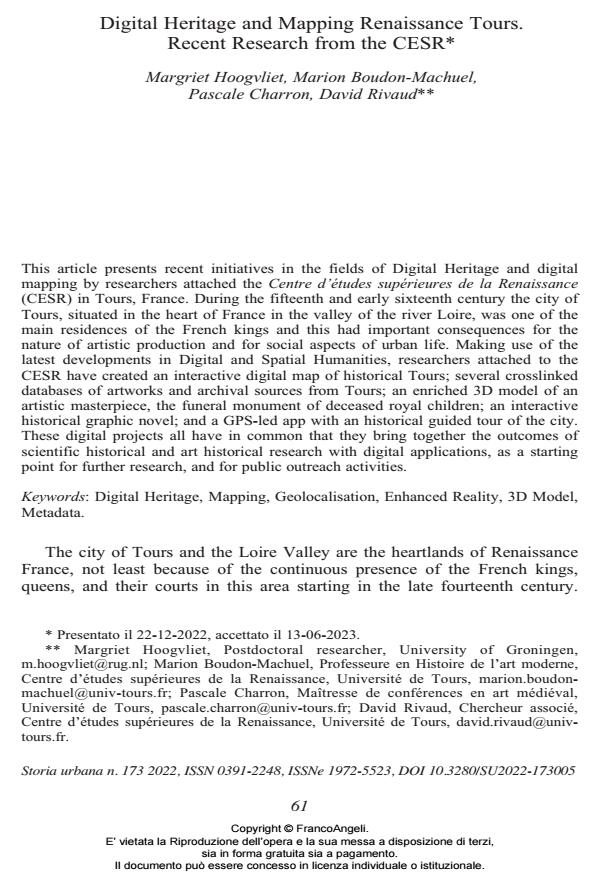Digital Heritage and Mapping Renaissance Tours. Recent Research from the CESR
Titolo Rivista STORIA URBANA
Autori/Curatori Margriet Hoogvliet, Marion Boudon-Machuel, Pascale Charron, David Rivaud
Anno di pubblicazione 2024 Fascicolo 2022/173
Lingua Inglese Numero pagine 18 P. 61-78 Dimensione file 407 KB
DOI 10.3280/SU2022-173005
Il DOI è il codice a barre della proprietà intellettuale: per saperne di più
clicca qui
Qui sotto puoi vedere in anteprima la prima pagina di questo articolo.
Se questo articolo ti interessa, lo puoi acquistare (e scaricare in formato pdf) seguendo le facili indicazioni per acquistare il download credit. Acquista Download Credits per scaricare questo Articolo in formato PDF

FrancoAngeli è membro della Publishers International Linking Association, Inc (PILA)associazione indipendente e non profit per facilitare (attraverso i servizi tecnologici implementati da CrossRef.org) l’accesso degli studiosi ai contenuti digitali nelle pubblicazioni professionali e scientifiche
This article presents recent initiatives in the fields of Digital Heritage and digital mapping by researchers attached the Centre d’études supérieures de la Renaissance (CESR) in Tours, France. During the fifteenth and early sixteenth century the city of Tours, situated in the heart of France in the valley of the river Loire, was one of the main residences of the French kings and this had important consequences for the nature of artistic production and for social aspects of urban life. Making use of the latest developments in Digital and Spatial Humanities, researchers attached to the CESR have created an interactive digital map of historical Tours; several crosslinked databases of artworks and archival sources from Tours; an enriched 3D model of an artistic masterpiece, the funeral monument of deceased royal children; an interactive historical graphic novel; and a GPS-led app with an historical guided tour of the city. These digital projects all have in common that they bring together the outcomes of scientific historical and art historical research with digital applications, as a starting point for further research, and for public outreach activities.
Questo articolo presenta le recenti iniziative nel campo del patrimonio e della map- patura digitali dei ricercatori del Centre d’études supérieures de la Renaissance (CESR) di Tours, in Francia. Durante il XV e all’inizio del XVI secolo la città di Tours, situata nel cuore della Francia nella valle del fiume Loira, fu una delle principa- li residenze dei re francesi con importanti conseguenze sulla natura della produzione artistica e sugli aspetti sociali della vita urbana. Utilizzando i più recenti sviluppi delle Digital and Spatial Humanities, i ricercatori del CESR hanno creato una mappa digita- le interattiva della Tours rinascimentale, diversi database incrociati di opere d’arte e fonti archivistiche di Tours, un modello 3D di un capolavoro artistico, il monumento funebre dei figli reali deceduti, una graphic novel storica interattiva e infine un’appli- cazione GPS con una visita guidata storica della città. Tutti questi progetti digitali han- no in comune il fatto di unire i risultati della ricerca scientifica storica e storico-artisti- ca con applicazioni digitali, come punto di partenza per ulteriori ricerche e per attività di divulgazione al pubblico.
Parole chiave:Patrimonio digitale, Mappatura Geolocalizzazione, Realtà aumentata Modello 3D, Metadati
Margriet Hoogvliet, Marion Boudon-Machuel, Pascale Charron, David Rivaud, Digital Heritage and Mapping Renaissance Tours. Recent Research from the CESR in "STORIA URBANA " 173/2022, pp 61-78, DOI: 10.3280/SU2022-173005